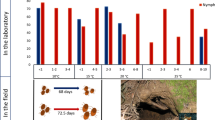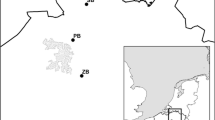Abstract
Ticks are extremely susceptible to desiccation when not on a host. Even though Ixodid ticks are capable of surviving extreme conditions, it is in the best interest of the tick to locate a host quickly. The aim of this study was to determine the host stimuli used by larval Ixodes hirsti for location of their passerine host. Additionally, we recorded the average questing height of larval ticks. We found that I. hirsti larvae were attracted to shade and heat, while they were unresponsive to host odor and CO2. The average questing height was 12.4 cm. Sensitivity to both shade and heat will aid larval I. hirsti in their ambush strategy to find a host. Preference for shaded environments and a low questing height favors the occurrence of larvae in high humidity environments. Such moist environments indirectly increase lifespan duration because of reduced movement for water sorption, and increase tick questing which is limited by vertical mobility. Additionally, larval ticks with a low questing height have a higher chance of encountering a ground foraging passerine host.

Similar content being viewed by others
References
Adeyeye OA, Butler JF (1991) Field evaluation of carbon dioxide baits for sampling Ornithodoros turicata (Acari: Argasidae) in gopher tortoise burrows. J Med Entomol 28:45–48
Anderson RB, Scrimgeour GJ, Kaufman WR (1998) Responses of the tick, Amblyomma hebraeum, to carbon dioxide. Exp Appl Acarol 22:1–15
Beelitz P, Gothe R (1991) Investigations on the host seeking and finding of Argas (Persicargas) walkerae (Ixodoidea: Argasidae). Parasitol Res 77:622–628
Belan I, Bull CM (1995) Host-seeking behaviour by Australian ticks (Acari: Ixodidae) with differing host specificities. Exp Appl Acarol 19:221–232
Bertrand MR, Wilson ML (1996) Microclimate-dependent survival of unfed adult Ixodes scapularis (Acari: Ixodidae) in nature: life cycle and study design implications. J Med Entomol 33:619–627
Camin JH, Drenner RW (1978) Climbing behavior and host-finding of larval rabbit ticks (Haemaphysalis leporispalustris). J Parasitol 64:905–909
Carroll JF, Klun JA, Schmidtmann ET (1995) Evidence for kairomonal influence on selection of host-ambushing sites by adult Ixodes scapularis (Acari: Ixodidae). J Med Entomol 32:119–125
Chapman TW, Marando L, Oorebeek M, Kleindorfer S (2009) Avian Ixodid tick movements between Kangaroo Island and the South Australian mainland. Aust J Entomol (in press)
Crooks E, Randolph SE (2006) Walking by Ixodes ricinus ticks: intrinsic and extrinsic factors determine the attraction of moisture or host odour. J Exp Biol 209:2138–2142
Goddard J (1992) Ecological studies of adult Ixodes scapularis in central Mississippi: questing activity in relation to time of year, vegetation type, and meteorological conditions. J Med Entomol 29:501–506
Hess E, Vlimant M (1983) The tarsal sensory system of Amblyomma variegatum Fabricius (Ixodidae, Metastriata). III. Mapping of sensory hairs and evolution of the relative importance of sensory modalities during post-embryonic development. Rev Suisse Zool 90:887–897
Howell FG (1975) The roles of host-related stimuli in the behavior of Argas cooleyi (Acarina: Argasidae). J Med Entomol 11:715–723
James AM, Oliver JH Jr (1990) Feeding and host preference of immature Ixodes dammini, I. scapularis, and I. pacificus (Acari: Ixodidae). J Med Entomol 27:324–330
Jander R (1975) Ecological aspects of spatial orientation. Annu Rev Ecol Syst 6:171–188
Kahl O, Knülle W (1988) Water vapour uptake from subsaturated atmospheres by engorged immature Ixodid ticks. Exp Appl Acarol 4:73–83
Kleindorfer S, Lambert S, Paton DC (2006) Ticks (Ixodes sp.) and blood parasites (Haemoproteus sp.) in New Holland honeyeaters (Phylidonyris novaehollandiae): evidence for site specificity and fitness costs. EMU 106:113–118
Knülle W, Rudolph D (1982) Humidity relationships and water balance of ticks. In: Obenchain FD, Galun R (eds) Physiology of ticks. Pergamon, Oxford, pp 43–70
Koch HG (1987) Estimation of absolute numbers of adult lone star ticks (Acari: Ixodidae) by dry ice sampling. Ann Entomol Soc Am 80:624–628
Lees AD (1946) The water balance in Ixodes ricinus L. and certain other species of ticks. Parasitology 37:1–20
Lees AD (1948) The sensory physiology of the sheep tick, Ixodes ricinus L. J Exp Biol 25:145–207
Lees AD, Milne A (1951) The seasonal and diurnal activities of individual sheep ticks (Ixodes ricinus L.). Parasitology 41:189–208
Loye JE, Lane RS (1988) Questing behaviour of Ixodes pacificus (Acari: Ixodidae) in relation to meteorological and seasonal factors. J Med Entomol 25:391–398
McMahon C, Guerin PM (2002) Attraction of the tropical bont tick, Amblyomma variegatum, to human breath and to the breath components acetone, NO and CO2. Naturwissenschaften 89:311–315
Mejlon HA, Jaenson TGT (1997) Questing behaviour of Ixodes ricinus ticks (Acari: Ixodidae). Exp Appl Acarol 21:747–754
Milne A (1950) The ecology of the sheep tick, Ixodes ricinus L. Microhabitat economy of the adult tick. Parasitology 40:14–34
Needham GR, Teel PD (1986) Water balance by ticks between bloodmeals. In: Sauer JR, Hair JA (eds) Morphology, physiology, and behavioural biology of ticks. Ellis Horwood, Chichester, pp 100–151
Needham GR, Teel PD (1991) Off-host physiological ecology of Ixodid ticks. Annu Rev Entomol 36:659–681
Oorebeek M, Rismiller P (2007) Bothriocroton concolor (Acari: Ixodidae) on the Kangaroo Island kangaroo: a new host–parasite relationship. J Med Entomol 44:901–902
Oorebeek M, Kleindorfer S (2008a) Climate or host availability: what determines the seasonal abundance of ticks? Parasitol Res 103:871–875
Oorebeek M, Kleindorfer S (2008b) Understorey predicts the spatial distribution of Ixodes hirsti in South Australia. Aust J Zool 56:123–127
Perret J-L, Guigoz E, Rais O, Gern L (2000) Influence of saturation deficit and temperature on Ixodes ricinus tick questing activity in a Lyme borreliosis-endemic area (Switzerland). Parasitol Res 86:554–557
Perret J-L, Guerin PM, Diehl PA, Vlimant M, Gern L (2003) Darkness induces mobility, and saturation deficit limits questing duration, in the tick Ixodes ricinus. J Exp Biol 206:1809–1815
Randolph SE, Storey K (1999) Impact of microclimate on immature tick–rodent host interactions (Acari: Ixodidae): implications for parasite transmission. J Med Entomol 36:741–748
Roberts FHS (1970) Australian ticks. Commonwealth Scientific and Industrial Research Organisation, Queensland
Sauer JR, Hair JA, Houts MS (1974) Chemo-attraction in the lone star tick (Acarina: Ixodidae). 2. Responses to various concentrations of CO2. Ann Entomol Soc Am 67:150–152
Solberg VB, Neidhardt K, Sardelis MR, Hildebrandt C, Hoffmann FJ, Boobar LR (1992) Quantitative evaluation of sampling methods for Ixodes dammini and Amblyomma americanum (Acari: Ixodidae). J Med Entomol 29:451–456
Sonenshine DE (1993) Biology of ticks, volume 2. Oxford University Press, Oxford
Sonenshine DE (1999) Maintenance of ticks in the laboratory. In: Maramorosch K, Mahmood F (eds) Maintenance of human, animal, and plant pathogen vectors. Science Publishers, Enfield, pp 57–82
Waladde SM, Rice MJ (1982) The sensory basis of tick feeding behaviour. In: Obenchain FD, Galun R (eds) Physiology of ticks. Pergamon, Oxford, pp 71–118
Webb JP (1979) Host-locating behavior of nymphal Ornithodoros concanensis (Acarina: Argasidae). J Med Entomol 16:437–447
Werder J, Gothe R (1993) Hyalomma truncatum and Rhipicephalus evertsi mimeticus (Ixodoidea, Ixodidae): reactions of adult ticks to vertically incident narrow- and wideband optical radiation with and without the influence of a CO2 gradient. Exp Appl Acarol 17:489–501
Wilson JG, Kinzer DR, Sauer JR, Hair JA (1972) Chemoattraction in the lone star tick. J Med Entomol 9:245–252
Acknowledgments
We extend sincere thanks to the organizations that have funded this research including: Australian Research Council, South Australian Department for Environment and Heritage, Sir Mark Mitchell Foundation, Nature Foundation SA Inc., Holsworth Wildlife Research Fund, and Conservation Council of South Australia. All procedures followed the Guidelines for the Use of Animals in Research (Flinders University).
Author information
Authors and Affiliations
Corresponding author
Rights and permissions
About this article
Cite this article
Oorebeek, M., Sharrad, R. & Kleindorfer, S. What attracts larval Ixodes hirsti (Acari: Ixodidae) to their host?. Parasitol Res 104, 623–628 (2009). https://doi.org/10.1007/s00436-008-1238-3
Received:
Accepted:
Published:
Issue Date:
DOI: https://doi.org/10.1007/s00436-008-1238-3




